Deadhorse, Alaska tourism offers a unique Arctic experience, but is it right for you? SIXT.VN provides expert travel advice and seamless booking services to help you explore the Alaskan wilderness with ease, from airport transfers to curated tours, ensuring a smooth and unforgettable adventure. Discover the top attractions and plan your journey today!
1. What Makes Deadhorse, Alaska a Unique Tourist Destination?
Deadhorse, Alaska, offers a unique appeal due to its remote location and industrial significance. Nestled in Prudhoe Bay on the North Slope, Deadhorse is primarily known as the support hub for the Prudhoe Bay Oil Field, the largest oil field in North America. This gives visitors a chance to witness large-scale industrial operations in an Arctic setting, which is quite unlike any other tourist destination.
Beyond the industrial aspect, Deadhorse provides access to the Arctic Ocean. The opportunity to stand on the edge of the world, dip your toes in the icy Arctic waters, and experience the vastness of the Arctic tundra is a major draw for adventurous travelers. The region also offers unique natural phenomena, such as the midnight sun in summer and the polar night in winter, creating distinct seasonal experiences. Moreover, the Dalton Highway, the road leading to Deadhorse, is an attraction in itself, offering stunning views of the Alaskan wilderness and opportunities for wildlife viewing.
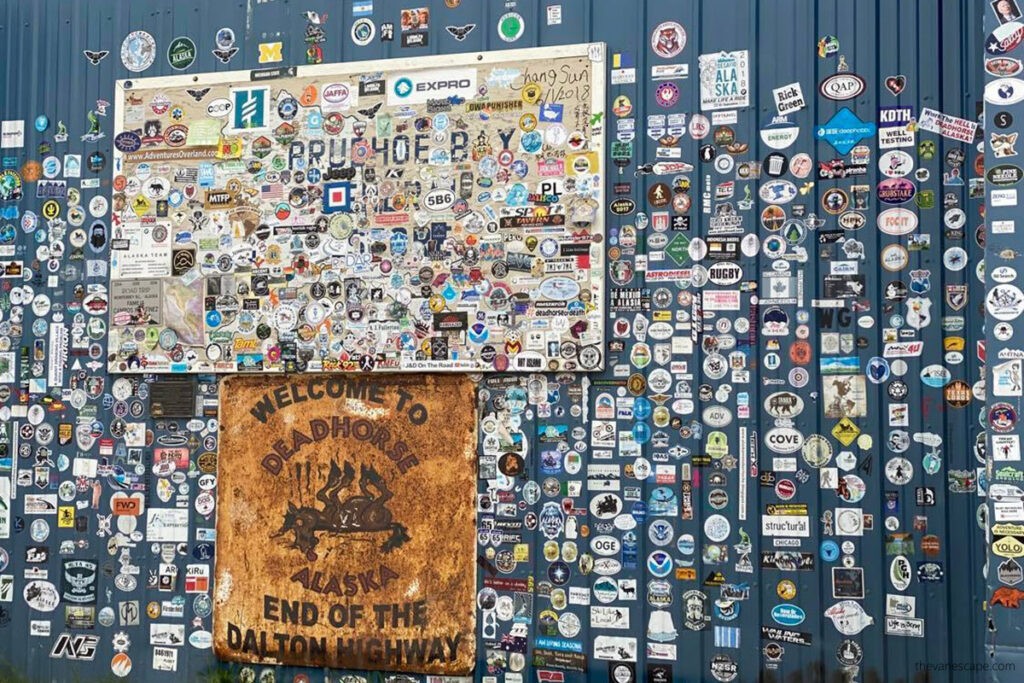 Welcome to Deadhorse, the end of the Dalton Highway, industrial landscape with modular buildings
Welcome to Deadhorse, the end of the Dalton Highway, industrial landscape with modular buildings
2. What Are the Top Attractions for Deadhorse Alaska Tourism in 2025?
Deadhorse, Alaska, though remote and industrial, offers several unique attractions for adventurous travelers in 2025.
- Arctic Ocean Shuttle Experience: Book a shuttle at Deadhorse Camp to reach the Arctic Ocean, available from May 25 to September 15. This is a must-do for the unique experience of standing on the edge of the Arctic.
- Polar Dip in the Arctic Ocean: For the brave, a quick dip in the Arctic Ocean is an exhilarating challenge.
- Prudhoe Bay Oil Fields: Witness the heart of North America’s largest oil field. Tours provide a glimpse into the vast industrial operations (limited access).
- Arctic Tundra Exploration: Discover the fragile ecosystem of the Arctic tundra with its unique vegetation.
- Wildlife Viewing: Spot local wildlife such as caribou, red foxes, and various bird species. Keep an eye out for muskox along the Dalton Highway.
- Grizzly Bear Sightings: Be cautious and respectful of the local grizzly bears. Observe them from a safe distance.
- Midnight Sun or Polar Night: Experience the unique phenomena of 24-hour daylight in summer (May 20 to July 22) or complete darkness in winter (November 24 to January 18).
3. How Can I Access the Arctic Ocean from Deadhorse, Alaska?
Accessing the Arctic Ocean from Deadhorse, Alaska, requires joining a guided tour or shuttle service due to security restrictions related to the Prudhoe Bay oil field. Personal vehicles are not permitted beyond certain points for safety reasons.
The most common and recommended option is to book the Arctic Ocean Shuttle at Deadhorse Camp. This shuttle service typically operates from late May to mid-September. The tour lasts approximately two hours and takes you from Deadhorse to the edge of the Arctic Ocean. Keep in mind that booking in advance is recommended, especially during peak season, as space is limited.
4. What Should I Know About the Dalton Highway Before Driving to Deadhorse?
The Dalton Highway, also known as the Haul Road, is a 414-mile gravel road stretching from near Fairbanks to Deadhorse, Alaska. This highway is known for its rugged conditions and remote nature, requiring careful planning and preparation.
- Vehicle Preparation: Ensure your vehicle is in excellent condition. High-clearance vehicles are recommended. Carry spare tires, tools, and extra fuel.
- Rental Restrictions: Most major rental companies prohibit driving on the Dalton Highway. Alaska Auto Rental in Fairbanks is one of the few that allows it with specially equipped vehicles.
- Safety: Drive cautiously and be aware of large trucks. Carry a CB radio to communicate with truckers. Watch out for potholes, loose gravel, and wildlife on the road.
- Supplies: Bring plenty of food, water, and emergency supplies. Gas stations are limited along the route.
- Weather: Be prepared for unpredictable weather conditions, including rain, snow, and strong winds.
- Scenery: Enjoy the stunning views of the Alaskan wilderness, including the Yukon River, Arctic Circle, Brooks Range, and the Trans-Alaska Pipeline.
- Accommodation: Limited lodging options are available in Coldfoot and Deadhorse. Book in advance.
- Gasoline Prices: Expect gasoline prices in Deadhorse to be significantly higher than in Fairbanks or Anchorage.
5. What Wildlife Can I Expect to See Near Deadhorse and the Dalton Highway?
The Dalton Highway and the Deadhorse area in Alaska offer excellent opportunities for wildlife viewing.
- Caribou: Large herds of caribou are often seen grazing on the tundra, especially during migration seasons.
- Grizzly Bears: Grizzly bears roam the region. Exercise caution and keep a safe distance.
- Muskox: These large, shaggy creatures are frequently spotted along the highway, particularly between Happy Valley and Franklin Bluffs.
- Arctic Foxes: These foxes are well-adapted to the cold climate and can be seen hunting in the tundra.
- Moose: While less common than caribou, moose can sometimes be spotted in wooded areas along the highway.
- Birds: The area is a haven for migratory birds. You may see swans, terns, geese, ducks, and loons.
- Wolves: While rarer, wolves also inhabit the region.
- Other Wildlife: Smaller mammals such as arctic hares, ground squirrels, and various rodents are also present.
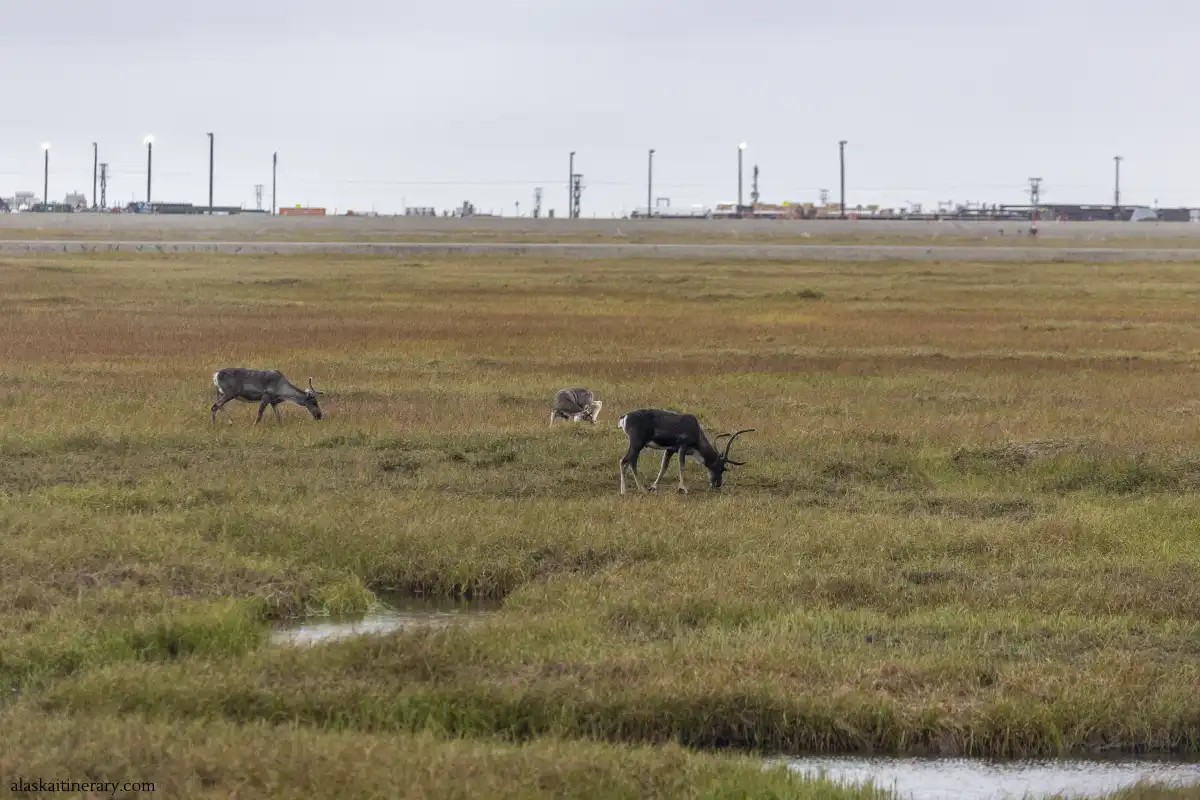 Caribou grazing near Prudhoe Bay, Alaska, in a vast tundra landscape
Caribou grazing near Prudhoe Bay, Alaska, in a vast tundra landscape
6. What Kind of Clothing Should I Pack for a Trip to Deadhorse?
Packing for a trip to Deadhorse, Alaska, requires preparing for extreme and unpredictable weather conditions.
- Layers: Dress in multiple layers to adjust to changing temperatures. Include a base layer of moisture-wicking fabric, an insulating layer (such as fleece or down), and a waterproof and windproof outer layer.
- Insulated Jacket: A high-quality, insulated parka is essential, especially if traveling during the colder months.
- Waterproof Pants: Waterproof and windproof pants will protect you from rain, snow, and wind.
- Warm Hat and Gloves: A warm hat that covers your ears and insulated gloves or mittens are crucial for protecting against the cold.
- Waterproof Boots: Sturdy, waterproof boots with good traction are necessary for navigating icy and uneven terrain.
- Warm Socks: Pack several pairs of warm, moisture-wicking socks (wool or synthetic).
- Sunglasses: Even in winter, the sun reflecting off the snow can be intense.
- Sunscreen: Protect your skin from the sun, especially during the summer months.
- Insect Repellent: Mosquitoes and other insects can be abundant during the summer.
- Thermal Underwear: Essential for cold-weather layering, providing extra warmth and moisture-wicking.
7. What Are the Accommodation Options Like in Deadhorse?
Accommodation options in Deadhorse are limited and primarily cater to workers in the Prudhoe Bay oil field.
- Basic and Functional: Hotels in Deadhorse are generally basic and functional, focusing on providing essential amenities rather than luxury.
- Cleanliness: Cleanliness is a priority, and rooms are typically well-maintained.
- Limited Amenities: Do not expect modern amenities such as fitness centers, swimming pools, or upscale restaurants.
- Cafeteria-Style Dining: Most hotels offer cafeteria-style dining, serving hearty meals to accommodate the working population.
- No Alcohol: Alcohol is typically not sold in Deadhorse.
- Modular Structures: Many buildings are modular and prefabricated, reflecting the industrial nature of the town.
- Book in Advance: Due to limited availability, it is essential to book your accommodation well in advance.
- Deadhorse Camp: This is one of the primary lodging options, offering shuttle services to the Arctic Ocean.
- Other Lodges: Other lodges include Prudhoe Bay Hotel and Arctic Oilfield Hotel.
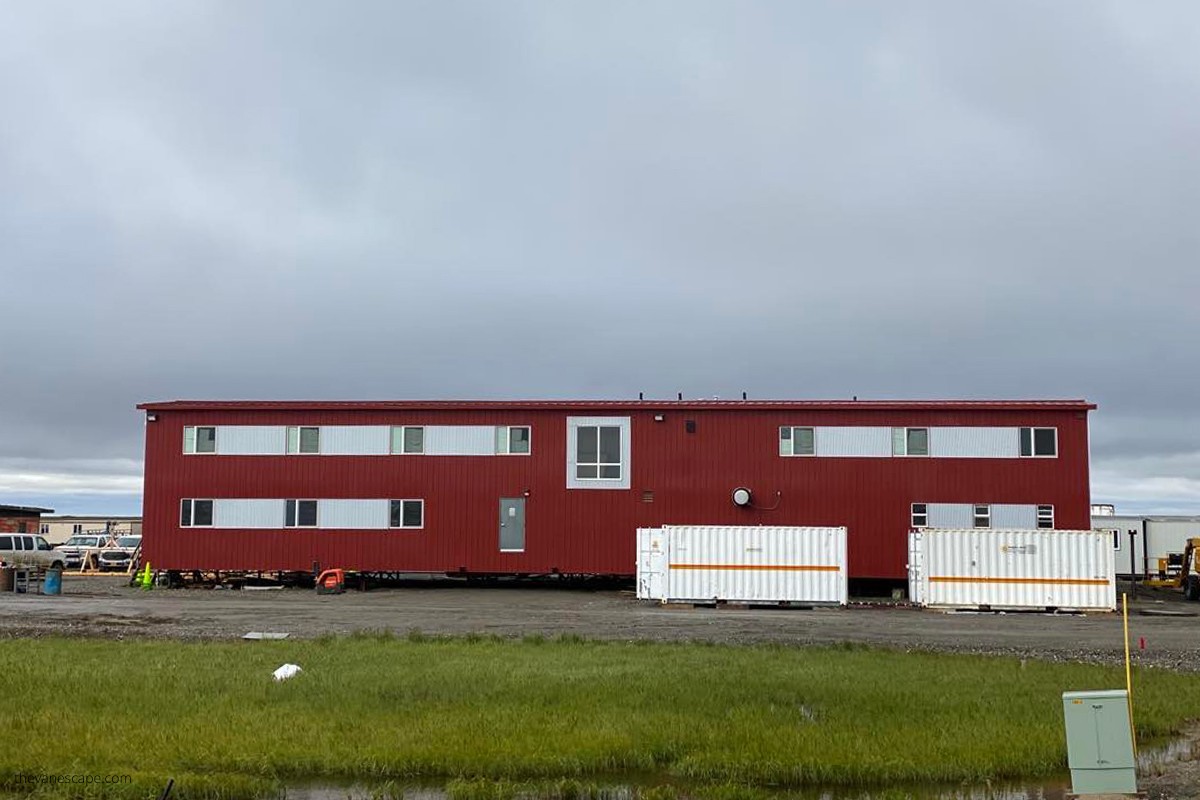 Deadhorse Camp, a functional lodging in Prudhoe Bay, built with modular structures to house oilfield workers and tourists
Deadhorse Camp, a functional lodging in Prudhoe Bay, built with modular structures to house oilfield workers and tourists
8. What is the Best Time of Year to Visit Deadhorse for Tourism?
The best time of year to visit Deadhorse for tourism depends on your interests and what you want to experience.
- Summer (May to September): Summer offers the midnight sun, 24 hours of daylight, making it ideal for continuous exploration. The Arctic Ocean Shuttle operates during these months. Wildlife is abundant, and temperatures are milder, though still cool.
- Winter (November to January): Winter brings the polar night, with extended periods of darkness. This is the best time to see the Northern Lights. The landscape is serene and moonlit.
- Shoulder Seasons (Late April/Early May & Late September/Early October): These periods can offer a mix of conditions. The Northern Lights may still be visible in early spring, and the tundra begins to show signs of life. Late September can offer fall colors in the Brooks Range.
9. Are There Any Guided Tours Available in Deadhorse Besides the Arctic Ocean Shuttle?
While the Arctic Ocean Shuttle is the most popular guided tour in Deadhorse, there are limited options for other organized tours within Deadhorse itself.
- Arctic Ocean Shuttle: This is the primary tour, taking visitors to the edge of the Arctic Ocean.
- Dalton Highway Tours from Fairbanks: Several companies offer multi-day tours from Fairbanks that include a visit to Deadhorse. These tours often cover the highlights of the Dalton Highway, such as the Arctic Circle, Yukon River, and Brooks Range.
- Flightseeing Tours: Consider flightseeing tours over the Brooks Range for a spectacular aerial view of the Arctic landscape.
- Custom Tours: Some local operators may offer custom tours based on your interests. Contact local visitor centers or lodges for more information.
10. What Should I Be Aware of Regarding Safety and Environmental Concerns in Deadhorse?
Safety and environmental concerns are paramount in Deadhorse due to its remote location and industrial activities.
- Wildlife Safety: Be aware of wildlife, especially grizzly bears. Carry bear spray and know how to use it. Store food properly and never approach or feed wildlife.
- Driving Safety: The Dalton Highway is challenging. Drive cautiously, be aware of large trucks, and carry emergency supplies.
- Industrial Hazards: Be mindful of industrial operations in the Prudhoe Bay oil field. Stay within designated tour routes and follow safety guidelines.
- Weather Conditions: The weather can change rapidly. Be prepared for extreme temperatures, strong winds, and snow.
- Environmental Sensitivity: The Arctic tundra is a fragile ecosystem. Stay on marked trails, avoid disturbing vegetation, and pack out all trash.
- Remote Location: Deadhorse is remote with limited medical facilities. Ensure you have adequate travel insurance and a well-stocked first-aid kit.
- Communication: Cell phone service is limited. Carry a satellite phone or CB radio for emergencies.
- Water Safety: If venturing near the Arctic Ocean, be aware of the dangers of cold water immersion.
11. How Does SIXT.VN Enhance My Travel Experience to Deadhorse, Alaska?
Planning a trip to a remote destination like Deadhorse, Alaska, can be challenging, but SIXT.VN streamlines the process with comprehensive travel solutions. SIXT.VN provides various services tailored to make your trip to Deadhorse as smooth and enjoyable as possible, even with the challenges of remote travel.
- Expert Travel Advice: SIXT.VN offers expert advice on planning your trip to Deadhorse, including the best time to visit, what to pack, and essential safety tips.
- Seamless Booking Services: The platform simplifies booking flights, accommodations, and tours, ensuring a hassle-free experience.
- Airport Transfers: SIXT.VN can arrange airport transfers, providing a convenient and reliable way to reach your lodging upon arrival in Alaska.
- Curated Tours: Discover and book curated tours that highlight the best of Deadhorse and the Dalton Highway, including Arctic Ocean shuttles and wildlife viewing expeditions.
- Customized Itineraries: Tailor your itinerary to match your interests, whether you’re focused on wildlife, industrial tours, or experiencing the Arctic landscape.
- 24/7 Support: Enjoy peace of mind with round-the-clock customer support, ensuring assistance is always available if you encounter any issues during your trip.
SIXT.VN is committed to providing you with the tools and support necessary to make your trip to Deadhorse a seamless and unforgettable adventure.
12. How Can I Balance Visiting Deadhorse with More Traditional Alaskan Tourist Activities?
Balancing a visit to Deadhorse with more traditional Alaskan tourist activities involves integrating the remote and industrial experience of Deadhorse with the natural beauty and recreational opportunities found elsewhere in Alaska.
- Start or End in Anchorage or Fairbanks: Plan your trip to start or end in Anchorage or Fairbanks, where you can enjoy a wider range of tourist activities, such as wildlife cruises, glacier tours, and cultural experiences.
- Include National Parks: Combine your Deadhorse trip with visits to other Alaskan national parks, such as Denali National Park, Kenai Fjords National Park, or Wrangell-St. Elias National Park.
- Scenic Drives: Enjoy scenic drives along the Parks Highway or Glenn Highway, offering stunning views of mountains, glaciers, and forests.
- Wildlife Viewing: Participate in wildlife viewing tours in areas like Seward or Homer, where you can see whales, sea otters, and puffins.
- Cultural Experiences: Explore Alaskan Native culture in communities like Sitka or Juneau, where you can visit museums, cultural centers, and historical sites.
- Fishing and Outdoor Activities: Take part in fishing, hiking, kayaking, or other outdoor activities in destinations like Soldotna or Valdez.
- Break Up the Drive: If driving the Dalton Highway, break up the journey with stops in towns like Coldfoot or Wiseman, where you can learn about the history and culture of the region.
By combining the unique experience of Deadhorse with other Alaskan attractions, you can create a well-rounded and memorable trip that showcases the diverse beauty and culture of the state.
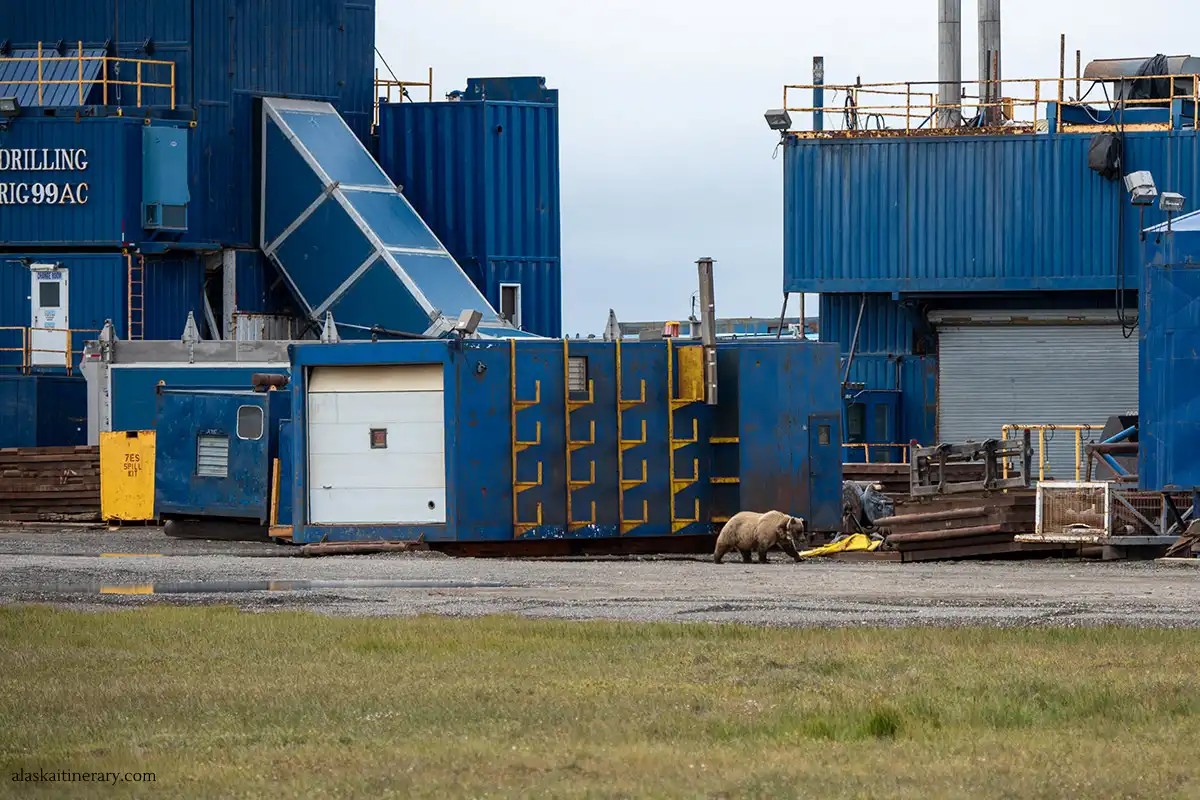 Grizzly Bear roaming near the industrial sites of Deadhorse, showing the overlap of human and wildlife territories
Grizzly Bear roaming near the industrial sites of Deadhorse, showing the overlap of human and wildlife territories
13. Are There Any Alternatives to Driving the Dalton Highway to Reach Deadhorse?
Yes, there are alternatives to driving the Dalton Highway to reach Deadhorse, Alaska, each offering a different experience and convenience level.
- Fly from Anchorage or Fairbanks: Alaska Airlines offers daily jet services from Anchorage or Fairbanks to Deadhorse. This is the quickest and most convenient option, especially if you are short on time.
- Guided Tours from Fairbanks: Several companies offer guided tours from Fairbanks that include transportation to Deadhorse. These tours often use vans or buses and cover the highlights of the Dalton Highway along the way.
- Air Taxi: Chartering an air taxi from Fairbanks is another option, offering a more flexible and personalized way to reach Deadhorse. However, this is generally more expensive than flying on a commercial airline.
14. How Can I Prepare for the Extreme Weather Conditions in Deadhorse?
Preparing for the extreme weather conditions in Deadhorse, Alaska, is essential for a safe and enjoyable trip.
- Layered Clothing: Dress in multiple layers to regulate your body temperature.
- Insulated Outerwear: Invest in a high-quality, insulated parka, waterproof pants, and sturdy, waterproof boots.
- Warm Accessories: Wear a warm hat, gloves or mittens, and thick socks to protect your extremities.
- Check the Forecast: Monitor the weather forecast regularly and be prepared for sudden changes.
- Emergency Supplies: Carry a survival kit with essentials such as a first-aid kit, flashlight, extra batteries, and a signaling device.
- Sun Protection: Even in cold weather, the sun can be intense, especially when reflected off the snow. Wear sunglasses and sunscreen.
- Stay Hydrated: Drink plenty of water to stay hydrated, even in cold temperatures.
- Avoid Overexertion: Pace yourself and avoid overexertion, as it can lead to hypothermia in cold weather.
15. What Essential Documents Should I Carry When Traveling to Deadhorse?
When traveling to Deadhorse, Alaska, carrying the essential documents ensures a smooth and hassle-free trip.
- Identification: A valid government-issued photo ID, such as a driver’s license or passport (especially if you are an international traveler).
- Airline Tickets: Printed or digital copies of your airline tickets.
- Hotel and Tour Confirmations: Confirmations for your hotel bookings and any tours or activities you have booked.
- Rental Car Agreement: If you plan to rent a car, bring a copy of the rental agreement and your driver’s license.
- Insurance Information: Copies of your health insurance card and travel insurance policy.
- Emergency Contacts: A list of emergency contacts, including phone numbers and addresses.
- Credit Cards and Cash: Credit cards and some cash for expenses, as not all places may accept credit cards.
- Medical Information: A list of any medical conditions, allergies, and medications you are taking.
- Permits or Licenses: Any necessary permits or licenses for activities such as fishing or hunting.
- Copies of Important Documents: Keep copies of your passport, driver’s license, and other important documents in a separate location from the originals.
16. What Are the Best Photography Spots in and Around Deadhorse?
Deadhorse and its surrounding areas offer unique photographic opportunities, from industrial landscapes to Arctic wildlife.
- Arctic Ocean: Capture the vastness of the Arctic Ocean.
- Prudhoe Bay Oil Fields: Photograph the industrial infrastructure of the oil fields.
- Tundra Landscape: Capture the unique vegetation of the Arctic tundra.
- Wildlife: Photograph caribou, grizzly bears, muskox, and arctic foxes.
- Dalton Highway: Photograph scenic views along the Dalton Highway.
- Midnight Sun or Northern Lights: Capture the unique phenomena of the midnight sun in summer or the Northern Lights in winter.
17. How Can I Respect the Local Environment and Culture While Visiting Deadhorse?
Respecting the local environment and culture while visiting Deadhorse ensures that this unique destination remains pristine for future generations.
- Stay on Marked Trails: Stick to designated trails and roads to avoid damaging the fragile tundra vegetation.
- Pack Out All Trash: Carry out everything you carry in, including food wrappers, bottles, and other trash.
- Avoid Disturbing Wildlife: Observe wildlife from a distance and never approach or feed animals.
- Respect Local Customs: Be mindful of local customs and traditions.
- Support Local Businesses: Support local businesses by purchasing goods and services from them.
- Conserve Resources: Conserve resources such as water and energy.
- Educate Yourself: Learn about the local environment and culture.
- Leave No Trace: Minimize your impact on the environment.
- Be Respectful of Industrial Operations: Be respectful of industrial operations and follow all safety guidelines.
- Obey Regulations: Follow all regulations and guidelines.
18. What Can I Expect in Terms of Communication and Internet Connectivity in Deadhorse?
Communication and internet connectivity in Deadhorse are limited due to its remote location.
- Cell Phone Service: Cell phone service is generally unreliable, with limited coverage.
- Internet Access: Internet access is available at some hotels and lodges, but it is typically slow and expensive.
- Satellite Phones: Satellite phones are the most reliable means of communication in Deadhorse.
- CB Radios: CB radios are commonly used by truck drivers on the Dalton Highway.
- Wi-Fi: Wi-Fi may be available at Deadhorse Camp and other lodges, but the speed and reliability can vary.
- Prepaid SIM Cards: Purchasing a prepaid SIM card from a local provider can be an option for limited data access if your phone is unlocked.
- Plan Ahead: Due to limited connectivity, it’s best to plan ahead and download any necessary maps or information before arriving in Deadhorse.
- Emergency Communication: Ensure you have a way to communicate in case of an emergency, such as a satellite phone or a pre-arranged communication plan.
19. What Are the Dining Options Like in Deadhorse?
Dining options in Deadhorse are limited and primarily cater to workers in the Prudhoe Bay oil field.
- Cafeteria-Style Dining: Most hotels and lodges offer cafeteria-style dining, serving hearty meals to accommodate the working population.
- Basic and Functional: Dining facilities are generally basic and functional.
- Limited Variety: Expect a limited variety of food options.
- Hotel Restaurants: Some hotels may have small restaurants or cafes.
- Packed Meals: Consider packing your own snacks and meals, especially if you have dietary restrictions.
- No Alcohol: Alcohol is typically not sold in Deadhorse.
- High Prices: Food prices can be high due to the remote location and logistical challenges.
- Catering Services: Some catering services may be available.
20. Is Deadhorse a Good Destination for Families with Children?
Deadhorse is generally not considered a typical destination for families with young children due to its remote location, industrial environment, and limited recreational activities.
- Limited Activities: There are few activities specifically geared towards children.
- Industrial Environment: The industrial environment may not be appealing to children.
- Long Travel Times: The long travel times to reach Deadhorse may be challenging for children.
- Limited Amenities: Amenities and services geared towards families are limited.
- Weather Conditions: The extreme weather conditions can be challenging for children.
- Educational Value: Visiting Deadhorse can be an educational experience for older children and teenagers interested in science, engineering, or the environment.
- Wildlife Viewing: Wildlife viewing opportunities may be of interest to some children.
- Consider Alternatives: Consider alternative destinations in Alaska with more family-friendly activities and amenities.
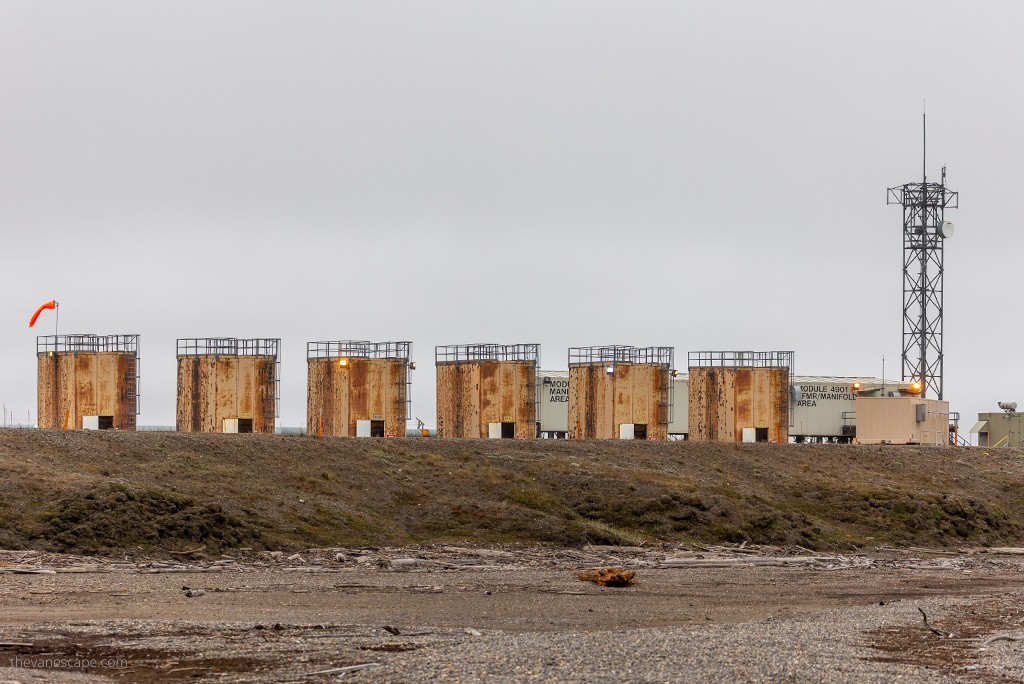 Industrial buildings at Arctic Ocean, Prudhoe Bay, with a gray sky highlighting the stark Arctic landscape
Industrial buildings at Arctic Ocean, Prudhoe Bay, with a gray sky highlighting the stark Arctic landscape
21. What Are Some Day Trip Options from Deadhorse?
While Deadhorse is a remote location, there are limited options for day trips, primarily focused on exploring the immediate surrounding area.
- Arctic Ocean Shuttle: The Arctic Ocean Shuttle is the most popular day trip, taking visitors to the edge of the Arctic Ocean.
- Prudhoe Bay Oil Fields Tour: Take a tour of the Prudhoe Bay Oil Fields to learn about the oil industry in Alaska.
- Walk Around Deadhorse: Take a walk around Deadhorse to see the industrial infrastructure.
- Wildlife Viewing: Drive or walk around the area to spot wildlife.
22. Are There Any Cultural or Historical Sites to Visit in Deadhorse?
Deadhorse is primarily an industrial town and does not have traditional cultural or historical sites. However, the town and its surroundings offer some unique aspects related to the oil industry and Arctic exploration.
- Trans-Alaska Pipeline System (TAPS): See the starting point of the Trans-Alaska Pipeline System.
- Prudhoe Bay Oil Field: Learn about the history and operations of the Prudhoe Bay Oil Field.
- Dalton Highway: Driving the Dalton Highway offers a glimpse into the history of Arctic transportation and logistics.
- Information Centers: Visit local information centers to learn about the history of the area and the oil industry.
- Nearby Communities: Consider visiting nearby communities such as Coldfoot or Wiseman to learn about the history and culture of the region.
23. What Budget Should I Plan for a Trip to Deadhorse?
Planning a budget for a trip to Deadhorse requires considering various factors, including transportation, accommodation, food, activities, and miscellaneous expenses.
- Transportation: Flights to Deadhorse can range from $300 to $800 or more, depending on the season and availability. If driving the Dalton Highway, factor in the cost of gas (which is more expensive in Deadhorse), vehicle maintenance, and potential rental fees.
- Accommodation: Hotel rooms in Deadhorse typically range from $200 to $400 per night.
- Food: Expect to spend around $50 to $100 per day on food.
- Activities: The Arctic Ocean Shuttle costs around $90 per person.
- Miscellaneous Expenses: Budget for souvenirs, emergency supplies, and other unexpected costs.
- Total Estimated Cost: A trip to Deadhorse can range from $2,000 to $5,000 or more per person.
24. What Are Some Common Misconceptions About Visiting Deadhorse?
There are several common misconceptions about visiting Deadhorse, Alaska, which can affect travelers’ expectations and planning.
- Deadhorse is a Picturesque Town: Deadhorse is primarily an industrial town with limited aesthetic appeal.
- It’s Easy to Access the Arctic Ocean: Access to the Arctic Ocean is restricted and requires joining a guided tour.
- Cell Phone Service is Readily Available: Cell phone service is unreliable in Deadhorse.
- There Are Plenty of Dining Options: Dining options are limited.
- It’s Warm in the Summer: Even in the summer, temperatures can be cool and unpredictable.
- Driving the Dalton Highway is Easy: The Dalton Highway is a challenging road.
- There’s a Lot to Do in Deadhorse: There are limited activities and attractions.
- It’s a Family-Friendly Destination: Deadhorse is generally not suitable for families with young children.
25. How Can I Make My Trip to Deadhorse More Environmentally Friendly?
Making your trip to Deadhorse more environmentally friendly involves several steps to minimize your impact on the fragile Arctic environment.
- Stay on Marked Trails: Stick to designated trails and roads to avoid damaging the tundra vegetation.
- Pack Out All Trash: Carry out everything you carry in, including food wrappers, bottles, and other trash.
- Use Reusable Items: Use reusable water bottles, shopping bags, and food containers.
- Support Sustainable Businesses: Support local businesses.
- Conserve Resources: Conserve resources such as water and energy.
- Respect Wildlife: Observe wildlife from a distance.
- Educate Yourself: Learn about the local environment and culture.
- Minimize Transportation Impact: Fly direct flights when possible.
- Offset Your Carbon Footprint: Consider offsetting your carbon footprint.
- Spread Awareness: Encourage others to travel responsibly.
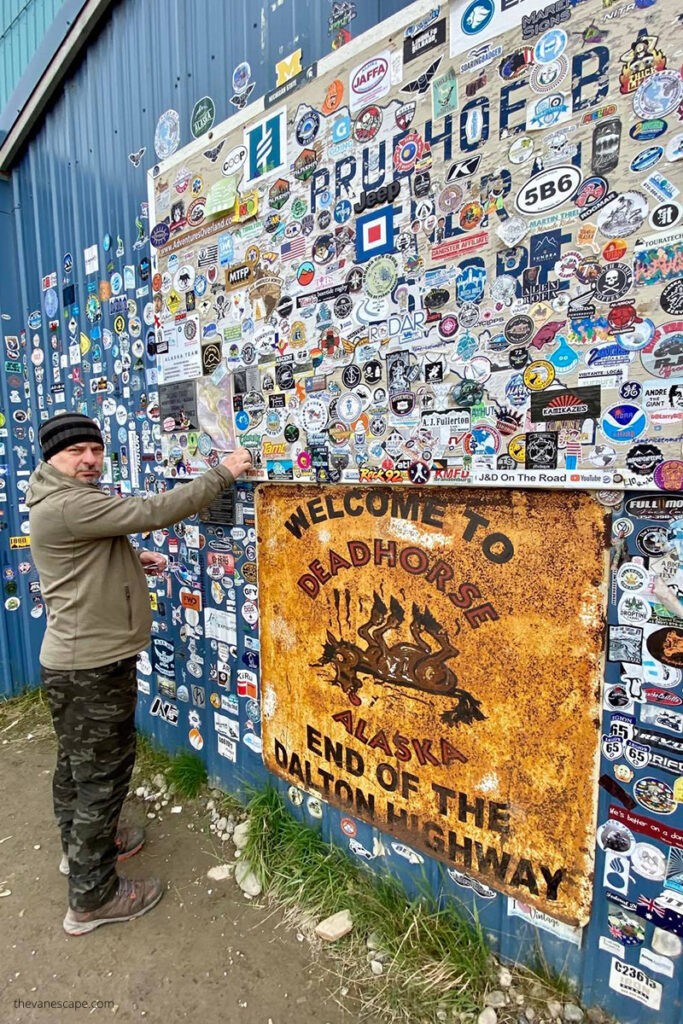 Chris standing next to a Deadhorse welcome sign, offering a glimpse of the town's utilitarian infrastructure
Chris standing next to a Deadhorse welcome sign, offering a glimpse of the town's utilitarian infrastructure
Ready to explore Deadhorse, Alaska? SIXT.VN makes planning your trip easy and stress-free. From airport transfers to custom tours, we’ve got you covered. Contact us today to start planning your adventure!
Address: 260 Cau Giay, Hanoi, Vietnam
Hotline/Whatsapp: +84 986 244 358
Website: SIXT.VN



